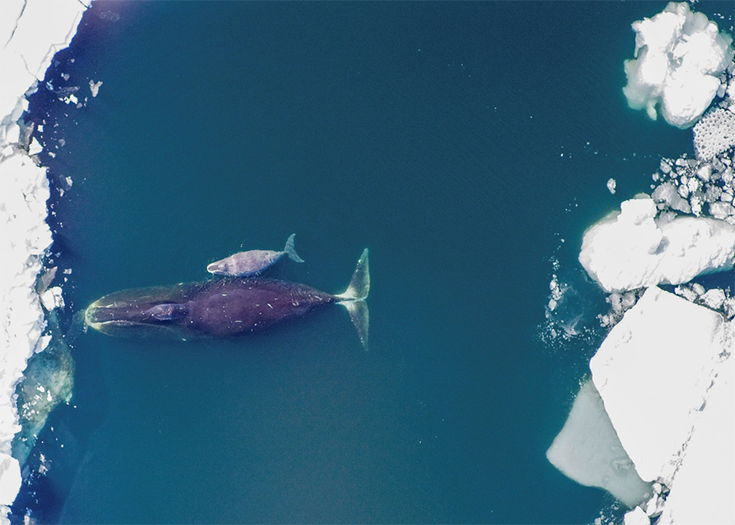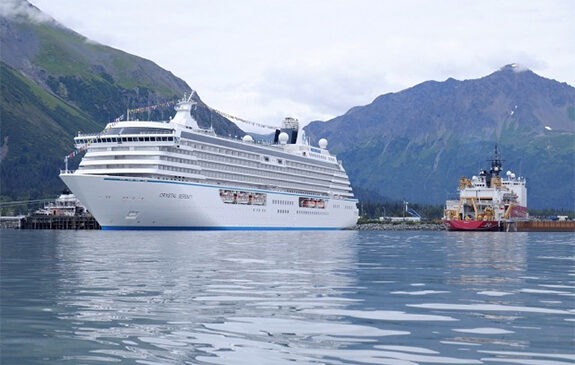
The Bering Strait
The Gateway to the Arctic
The Bering Strait may be narrow, but it’s teeming with wildlife.
Located between Alaska and Russia, the Bering Strait is the only marine gateway between the icy Arctic and the Pacific Ocean. At its narrowest point, the strait is only 55 miles wide.
The Bering Strait may be narrow, but it’s teeming with wildlife—beluga whales, bowhead whales, gray whales, walruses, polar bears, ringed and ribbon seals.
Each spring, one of the largest wildlife migrations on Earth passes through this narrow gateway to reach the Arctic’s incredibly nutrient-rich and productive waters.
But as Arctic sea ice continues to melt earlier in the season, more and more ships are beginning to use this narrow gateway. With increasing ship traffic comes more noise and water pollution and a higher risk of ship strikes on whales and damaging oil spills—including spills of toxic and long-lasting heavy fuel oil.
The Bering Strait is both a bottleneck and a pathway, home to species superbly adapted to this dynamic environment. It’s a place like nowhere else on earth, and one that we must fight to protect.
Narrow in Size, but BIG on Importance
The Bering Strait region provide habitat for many whale species, including bowhead whales, beluga whales, gray whales, orcas, and humpback whales. Other marine mammals that use the Bering Strait include walruses; bearded, spotted and ringed seals; and polar bears.
The Bering Strait region is home to some of the largest concentrations of breeding seabirds in North America: an estimated 12 million seabirds nest and forage in and around the Bering Strait. The region includes a number of designated “Important Bird Areas,” which are places of essential habitat for specific bird species. Birds that gather in the Bering Strait include puffins, murres, red phalaropes, black-legged kittiwakes, and least, parakeet and crested auklets.
While on their record-setting journey, the Arctic Tern spends time in the Bering Strait region. Famous as long-distance fliers, some Arctic Terns may migrate farther than any other birds, going from the high Arctic to the Antarctic. The waters around the Bering Strait provide habitat for nesting and breeding—as well as food and nutrients.
One of the Largest Migrations in the World
Springtime in the Bering Strait brings one of the largest migrations in the world. Each year, millions of birds and hundreds of thousands of marine mammals follow retreating sea ice north through the Bering Strait. Throughout the journey, ice-dependent seals use the sea ice for resting and feeding, while polar bears and walruses use the ice to hunt.
It Has a Rich History
For countless generations, residents of Bering Strait communities have hunted and fished in the region’s rich waters and on the sea ice that forms each winter. This subsistence way of life is inextricably connected to the health of the marine ecosystem. Now, warming temperatures, melting sea ice and other changes are impacting traditional subsistence practices and pose significant challenges to Bering Sea communities.

A Melting Arctic and Transportation Challenges
The Bering Strait is so remote that the only mode of transportation to the area is by air and water. And, you have to time your travel just right. Travel conditions are safest mainly in summer months when the weather is permitting.
As sea ice continues to melt, the passage through the Bering Strait has become easier for vessels, and commercial shipping interest is increasing. Recently, a luxury cruise ship was able to sail from the North Pacific to the Atlantic via the fabled Northwest Passage—a route that once defeated even the most intrepid explorers. The Crystal Serenity sailed from the Alaskan port of Seward through the Northwest Passage to New York City. While other cruise ships have made the transit, this is the first time a ship of this size—almost the length of three football fields—has made the passage.
Crystal Serenity’s journey is yet another symbol of a rapidly changing Arctic—and another reminder that the Bering Strait is under threat. Retreating sea ice is shrinking crucial habitat while increasing the potential for oil and gas exploration, shipping and other industrial activities that contribute to higher levels of vessel traffic. Higher traffic levels in these icy, foggy and rough seas increase the risk of oil spills and other accidents that could cause irreversible damage to the marine ecosystems and jeopardize the ability of Bering Strait communities to hunt and fish in their local waters.

It’s a Place Like Nowhere Else on Earth—and it’s Worth Protecting
The Arctic is heating up fast. As sea ice melts, more water is opening up for ship traffic and oil drilling, posing a threat to Arctic wildlife—the perfect recipe for disaster.
